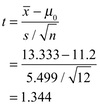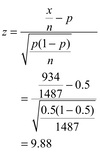
7.6 With 12 - 1 = 11 degrees of freedom, the cutoff for a 5 percent two-tailed test is 2.201. Here, the sample mean is 13.333 and the standard deviation 5.499, so that the t value,

is not large enough to reject the null hypothesis at the 5 percent level. Since statistical software shows that P[t > 1.344] = 0.1030, the two-sided P value is 2(0.1030) = 0.206.
7.10 We can use the binomial distribution with p = 0.5 and n = 83 + 26 = 109. Of 109 injuries, the probability that more than 82 would be female is

7.30 Because the z value is much larger than the requisite 1.96, the null hypothesis is rejected decisively:

Were the null hypothesis true, the probability of a z value greater than or equal to 9.88 is less than 0.0000000001.
7.36 The binomial probability is

which implies a two-tailed p-value of 2(0.0845) = 0.1690 and does not reject the null hypothesis that Mindy is a guesser at the 5 percent level. This report is data mining in that, each year, there are undoubtedly many such experiments throughout the country, and only the successful ones get reported to Sports Illustrated. For every 20 such tests, we expect 1 to show a statistically significant predictive ability by lucky guesses alone. It is data mining to report this 1 and forget the other 19.
7.48 For each of these three food categories, we need to calculate the sample mean and standard deviation, and (taking into account the sample size) calculate how many standard errors the sample mean is from zero:

Here are the results:
| National | Regional | Local | |
| Mean | 0.125 | 25.125 | 81.750 |
| Standard deviation | 10.520 | 16.074 | 83.969 |
| Sample size | 20 | 12 | 8 |
| t value | 0.053 | 5.415 | 2.754 |
| Two-sided P value | 0.958 | 0.0002 | 0.0284 |
The evidence against the null hypothesis that the population mean is zero is most persuasive for the regional foods. The P value is not as low for local foods, even though the sample mean is farther from 0, because the standard deviation is larger and the sample size is smaller; still the two-sided P value of 0.0284 does reject the null hypothesis at the 5 percent level. These percentage differences also seem substantial. For nationally advertised foods, the difference between the sample mean and 0 is not substantial and far from statistical significance.